Recent Progress in Preparation of Superhydrophobic Surfaces: A Review ()
1. Introduction
Biomimetic surfaces and materials received great attention of scientists and engineers due to their unusual properties. Biologically inspired design, adaptation, or derivation from nature is referred to as “biomimetics” [1] Biological tiny structures have been observed on many kinds of surfaces such as lotus leaves, rice leaves, butterfly wings, mosquito eyes, moth eyes, cicada wings, red rose petals, gecko feet, desert beetle, spider silks, and fish scales which exhibit excellent hydrophobicity and/or superhydrophobicity [2-6]. Such natural structures offer new insights into the design of artificial superhydrophobic structures. A superhydrophobic surface is a surface on which a drop of water forms an almost perfect sphere and even a very slight tilting is sufficient to cause the water drop to roll off. In addition to high water contact angle and low sliding angle, the ability of a surface to bounce off water droplets constitutes the third property of a superhydrophobic surface that is important for both biological and technical applications [7]. These surfaces are of special interest, because properties such as anti-sticking, anti-contamination, and self-cleaning are expected. These properties are attractive for many industrial and biological applications such as anti-biofouling paints for boats, antisticking of snow for antennas and windows, self-cleaning windshields for automobiles, microfluidics, lab-on-a-chip devices, metal refining, stain resistant textiles, anti-soiling architectural coatings, dust-free coatings on building glasses and so on [8-12].
Recently, a research work has been devoted towards the preparation and theoretical modelling of superhydrophobic surfaces as observed by the large number of publications and diverse approaches. Many strategies to create superhydrophobic surfaces have been put forward. Many of the preparation techniques are simple, inexpensive; however, some of them involved multistep procedures and harsh conditions, or required specialized reagents and equipment. Up to now, procedures of roughening the surface followed by hydrophobization or transforming low-surface-energy materials into rough surfaces have been commonly used to produce superhydrophobic surfaces. The various methods for the preparation of biomimetic superhydrophobic surfaces since last two decades have been reported, such as phase separation [13], electrochemical deposition [14], template method [15,16], Emulsion [17], plasma method [18], crystallization control [19], chemical vapor deposition [20], wet chemical reaction [21], sol-gel processing [22-25], lithography [26], electrospinning [27], solution immersion [28] and so on [29-31]. Besides water repellency, other properties such as transparency, colour change, anisotropy, reversebility, flexibility, electrowetting, and breathability have also been incorporated into biomimetic superhydrophobic surfaces [32-35]. Although there are many exciting challenges facing this field, there are a number of opportunities in design, synthesis, and engineering of superhydrophobic surfaces and nature serves as a merchant of endless inspirations. Since last decade, many significant review articles have been published describing the different synthesis strategies to fabricate artificial superhydrophobic surfaces [36-41].
This review will focus on the most recent developments (the last four years) in the superhydrophobic surface research. The major part of this review is organized in four sections. The first section gives a brief introduction about the superhydrophobic surfaces. In the second section, we review the theoretical basis relevant to the wetting of a solid surface by a liquid. The third section provides a comprehensive overview on the approaches for the preparation of superhydrophobic surfaces, with particular focus on the fabrication methodology, materials, micro-/ nanostructures and potential industrial applications. Finally in the fourth section, we will provide our personal prospects and research directions about the construction of superhydrophobic surfaces. Due to the space limitation, we cannot review all the significant and interesting work in the active superhydrophobic field.
2. Theoretical Background
2.1. Young’s Equation
When a drop of liquid is placed onto a solid surface, it forms a so-called contact angle (θ). The Young’s equation for the contact angle (q) of a liquid can be applied only to a flat surface and not to a rough one. The contact angle of a liquid on a perfectly smooth and chemically homogeneous solid surface is given by Young’s equation [42]:
 (1)
(1)
where, gsv, gsl and glv are the interfacial tensions of the solid-vapor, solid-liquid and the liquid-vapor interface, respectively (Figure 1(a)). Wetting of realistic surfaces which are rough and chemically heterogeneous is more complex. The earliest work on the effect of surface roughness on contact angle was done by Wenzel and Cassie & Baxter.
2.2. Wenzel’s Equation
Wenzel [43] developed a model where the liquid may completely penetrate into the rough grooves (Figure 1(b)), and the contact angle on rough surfaces is given by the following equation:
 (2)
(2)
In this equation, qw is the contact angle on a rough surface, q is the Young’s contact angle on a similar smooth surface, and r is the surface roughness factor, defined as the ratio between the actual and projected surface area (r = 1 for a perfectly smooth surface, and r > 1 for a rough one). The Wenzel equation predicts that wetting is enhanced by roughness, when q is < 90˚; and the wetting is lessened by roughness, when q is > 90˚. However, when q > 90˚, under some roughness condition, air bubbles may be trapped in the rough grooves. In this case, the liquid droplet is actually situated on a composite surface, and the wetting behaviour is described by Cassie & Baxter.
2.3. Cassie-Baxter’s Equation
The Cassie-Baxter state, also known as the composite or heterogeneous state, is a wetting state where, it is considered that the grooves under the droplet are filled with vapor instead of liquid, as schematically shown in Figure 1(c). This state is first described by Cassie and Baxter [44]. In this case, the liquid-surface interface is actually an interface consisting of two phases, namely a liquidsolid interface and a liquid-vapor interface. And the apparent contact angle is the sum of all the contributions of the different phases as described below:
 (3)
(3)
where θc is the apparent contact angle, f1 and f2 are the surface fractions of phase 1 and phase 2, respectively; θ1 and θ2 are the contact angles on phase 1 and phase 2, respectively. This equation is the general form, which also applies when there is no roughness. When one of these surfaces is the air-liquid interface, f is the solid fraction, defined as the fraction of the solid surface that is wetted by the liquid. Then the air fraction is (1 – f). With θ = 180˚ for air, the resulting contact angle can be calculated by the following equation:
 (4)
(4)
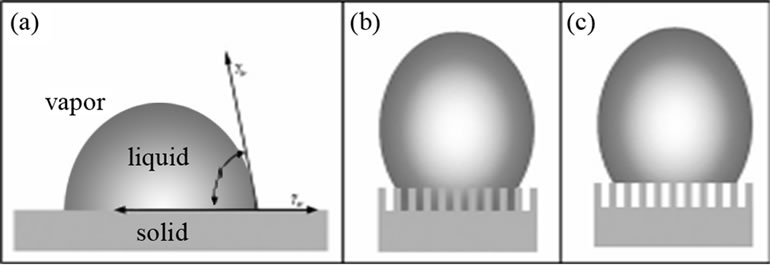
Figure 1. The wetting behaviour of a liquid droplet on rough solid surface: (a) Young’s mode; (b) Wenzel’s mode; (c) Cassie’s mode.
The parameter f ranges from 0 to 1, where at f = 0 the liquid droplet does not touch the surface at all and at f = 1 the surface is completely wetted, the same as the behaviour of a flat surface. When a droplet is in the CassieBaxter state, the small contact area between the liquid droplet and solid surface allows the droplet to roll easily over the surface.
2.4. Transition between Cassie and Wenzel States
In general, liquid droplets in the Wenzel state on rough surfaces show high sliding angle value than in the Cassie state [45]. In reality, the solid/liquid contact mode will change from the Cassie to the Wenzel state under the conditions of droplet press, impact or vibration [46,47]. Besides the state transitions, recently, Zeng et al. [48] showed that the two states can coexist on a nanopillared surface. They showed the simulation evidence of coexisting Wenzel/Cassie state for water droplets on a pillared hydrophobic surface. There generally exists a critical pillar height beyond which water droplets on pillared hydrophobic surfaces can be in the bistable Wenzel/Cassie state, depending on the initial location of the droplets.
3. Synthesis Routes Used for the Superhydrophobic Surfaces
To synthesize the superhydrophobic surfaces, recently many elegant chemical and physical routes have been applied. Many routes to prepare superhydrophobic surfaces require complicated, sometimes costly equipment, although some surfaces can be fabricated quite easily. It will be shown that different methods can be used for fabricating superhydrophobic surfaces with their advantages and limitations.
3.1. Electrochemical Deposition
The micro-/nanostructured surface required for the superhydrophobicity has been prepared by employing a versatile electrochemical deposition. Recently, He et al. [49] reported an electrochemical anodization method to synthesize different ZnO nanostructures in large area scale by using the mixed hydrofluoric acid and methanol electrolyte. In less than one hour, the different kinds of nanostructures such as ZnO nanodots, nanowires and nanoflowers were obtained by controlling the concentration of the electrolyte and reacting times (Figure 2).
They also demonstrated the change in surface wettability by the application of external potential on the ZnO nanostructure films, which is ascribed to the generation of surface defective sites on ZnO films under effect of electric field. Huang et al. [50] utilized one-step deposition process to prepare superhydrophobic copper surfaces. In their work, a direct voltage (DC) was applied between two copper plates immersed in a dilute ethanolic stearic acid solution. The surface of the anodic copper electrode transformed to superhydrophobic due to a reaction between copper and stearic acid solution. The surface of the anodic copper is found to be covered with flower-like low surface energy copper stearate films providing the water contact angle of 153˚ ± 2˚ with the roll-off properties. Figure 3 shows the increase in water contact angle and the decrease in contact angle hysteresis of anodic copper electrode at 3 h of application of DC voltage in an ethanolic stearic acid solution.
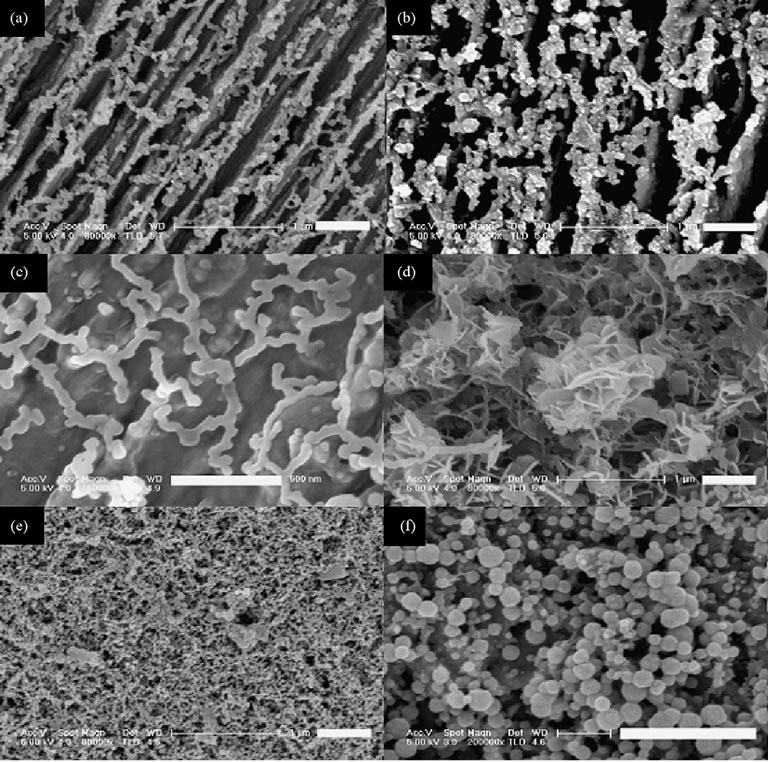
Figure 2. SEM images of ZnO nanostructures grown on the Zn foil with different reaction times in a mixed solution of methanol and water (50 vol% methanol, 1 mass% HF): (a) Sample A, 30 s; (b) Sample B, 1 min; (c) Sample C, 5 min; (d) Sample D, 10 min; (e) Sample E, 15 min; (f) Sample F, 30 min. The length of inserted scale bars is 500 nm. Images reprinted from Ref. [49], with permission from Elsevier, Copyright 2010.
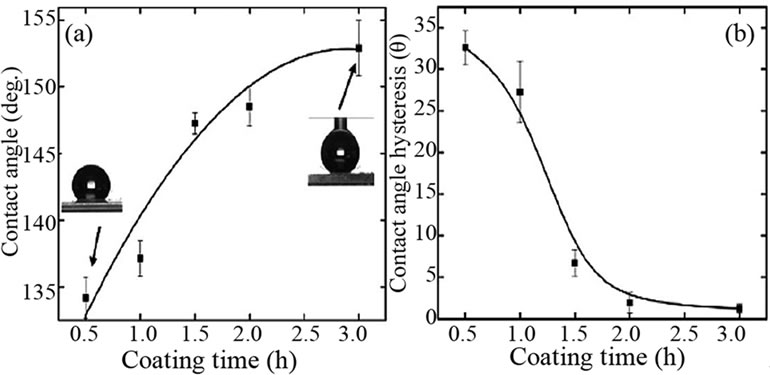
Figure 3. (a) Water contact angle and (b) contact angle hysteresis of anodic copper electrode with the application of 30 V DC voltage in an ethanolic stearic acid solution. The insets show the water drops on the copper surfaces coated for 0.5 h and 3 h. Images reprinted from Ref. [50], with permission from Elsevier, Copyright 2010.
Meng et al. [51] succeeded in fabricating interesting superamphiphobic surfaces, which are super-repellent both to water and oil, upon common engineering metals (zinc, aluminum, iron, and nickel) and their alloys (Zn-Fe alloy and brass) by taking advantage of an electrochemical reaction in perfluorocarboxylic acid solutions. Via control over the chain length, concentration of perfluorocarboxylic acid, and the process time, textured rough structures on different substrates were achieved. Figure 4(a) and its inset displayed the SEM images of the prepared films over zinc substrates; the petal-like nanosheet structures completely spread all over, with thickness ranging from about thirty to several hundred nanometers and micrometer scale length and height. The camera pictures and contact angle profile of water and oil droplets setting on the as-prepared film were demonstrated in Figures 4(b) and (c), which showed excellent water and oil repellency. The prepared surfaces showed superamphiphobicity due to the synergistic effect of their special surface compositions and microscopic structures.
Wang et al. [52] proposed a templateless, surfactantless, electrochemical route to directly fabricate hierarchical spherical cupreous microstructures (HSCMs) on an indium tin oxide (ITO) substrate. After further chemisorptions of a self-assembled monolayer of n-dodecanethiol, the as-prepared compact surface becomes superhydrophobic with a contact angle as high as 152˚. Li et al. [53] prepared superhydrophobic 3D porous copper films with a typical integration of micro-/nanostructure by means of hydrogen bubbles as the dynamic template for metal electrodeposition. Since the films were electrodeposited and grew within the interstitial spaces between the hydrogen bubbles, the pore diameter and wall thickness of the porous copper films were successfully tailored by adjusting the concentration of the electrodeposition electrolyte.
3.2. Electrospinning Method
Electrospinning is a simple but versatile method to produce
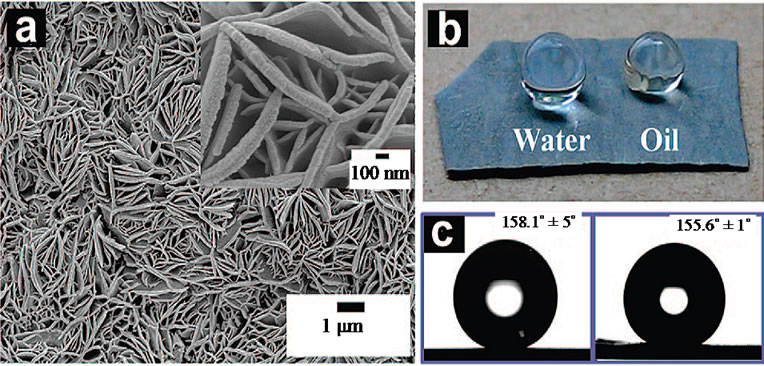
Figure 4. (a) Large-area SEM image of the prepared petallike surface; the inset is a high resolution SEM image. (b) The camera pictures of water and oil droplets setting on the as-prepared surface. (c) Contact angle profiles of water droplet (left) and oil droplet (right) on the surface. Images reprinted from Ref. [51], with permission from American Chemical Society, Copyright 2008.
continuous fibers with diameters ranging from nanometer to submicron scale. It is an extrusion process where an electrical bias is applied from the extrusion nozzle and a grounded collection plate. Pullulan (PULL) is a natural polymer and recently Islam et al. [54] prepared superhydrophobic (PULL) membrane by the electrospinning of the fluorinated silane functionalized PULL (Figure 5). It was observed that both 9 wt% and 12 wt% PULL membranes can only reach contact angles lower than 150˚ by electrospinning of pure PULL solutions. Superhydrophobic membranes with contact angles of up to 155˚ and 151˚ was achieved by electrospinning 9 wt% and 12 wt% PULL coupled with fluorinated silane, respectively.
The electrospun PS fibers on silicon wafer was synthesized by Kang et al. [55] which exhibited superhydrophobicity because of the unique protuberant structure formed on their surface, which is similar to the hierarchical structure of lotus leave.
Park et al. [56] demonstrated the fabrication of solventresistant, mechanically robust, superhydrophobic nanofibrous mats by electrospinning of poly(vinylidene fluoride) (PVDF) in the presence of inorganic silane material, tetraethyl orthosilicate (TEOS). The solvent resistance and mechanical strength of nanofibrous mats were improved through the crystallization of as-spun PVDF fibers or incorporation of a TEOS sol into the nanofibrous matrix. The electrospun nanofibrous mats yielded a water
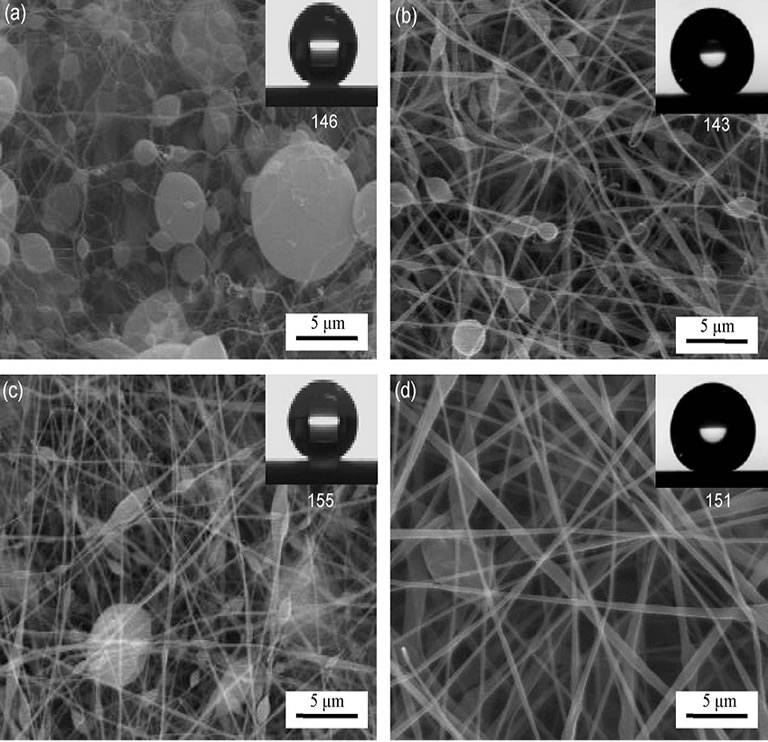
Figure 5. SEM images of membranes prepared from (a) 9 wt% PULL, (b) 12 wt% PULL, (c) 9 wt% PULL/PFOTES and (d) 12 wt% PULL/PFOTES using electrospinning method (applied voltage = 15 kV, TCD = 15 cm, and PFOTES concentration = 1 wt%). The water drops on the respective membranes are shown in the insets. Images reprinted from Ref. [54], with permission from Elsevier, Copyright 2010.
contact angle of 156˚ that did not vary with TEOS content. Almost similar to this, superhydrophobic polystyrene (PS) surfaces with mechanical integrity were successfully prepared by Zhan et al. [57] using advanced electrospinning method. Two types of PS fibers, bead onstring fibers and microfibers (Figure 6), generated a novel composite electrospun mat which allows for the superhydrophobic surface by increased surface roughness and at the same time significantly improved mechanical property of electrospun sheet. The value of water contact angle and the mechanical property of electrospun composite film were controlled by altering the mass ratio of bead-on-string fibers/micro-sized fibers.
3.3. Wet Chemical Reaction
For commercial and industrial adoption of truly largescale, multi-material, and hierarchical superhydrophobic functionality, a simple wet chemical coating is ideal. Qi et al. [58] demonstrated a simple technique for generating a wafer-scale superhydrophobic and antireflective structured silicon surface with chemical etching.
By employing the KOH etching and silver catalytic etching, pyramidal hierarchical structures were generated on the crystalline silicon wafer (Figure 7), which exhibit strong antireflection and superhydrophobic properties after fluorination. After the fluoroalkylsilane treatment, the structured surface exhibits the contact angle of 169˚ and the sliding angle of less than 3˚. The duration of silver-assisted etching plays an important role on the superhydrophobic characteristics, which should be less than 30 s, otherwise the pyramid structure will be damaged and the superhydrophobicity will be degraded. In the same way, monoalkyl phosphonic acid was used to prepare stable and durable superhydrophobic surface on nickel substrates with a wet chemical process. The flowery microstructures were gradually formed due to the chemical reaction between Ni and monoalkyl phosphonic acid, constituting a continuous slipcover [59]. A superhydrophobic rough structure was prepared by Pan et al. [60] on copper wafer via HNO3 etching technique with the assistance of Cetyltrimethyl Ammonium Bromide (CTAB) and ultrasonication. After modification with 1H,1H,2H, 2H-perfluorodecyltriethoxysilane (FDTES), the copper wafer showed stable superhydrophobicity. Dense and spherical micropits appeared on copper wafer after it was etched by 5 M nitric acid with 1.2 mM CTAB under ultrasonication. The microstructure studies (Figure 8) indicated that the joint action of CTAB and ultrasonication caused the formation of dense and spherical micropits. The as prepared surfaces also showed superhydrophobic properties not only for water but also for corrosive liquids. These results are very important for the use of copper as superhydrophobic engineering materials both
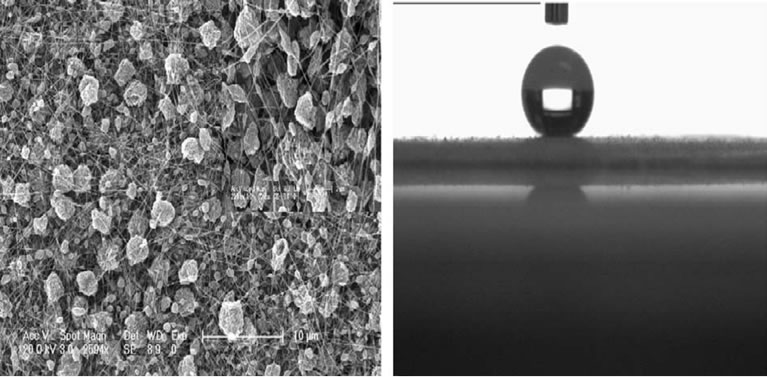
Figure 6. (a) Scanning electron microscope image of electrospun film prepared from 4 wt% PS/DMF solution; (b) Behavior of a water droplet on its surface. CA = 154.65˚. Images reprinted from Ref. [57], with permission from Elsevier, Copyright 2010.
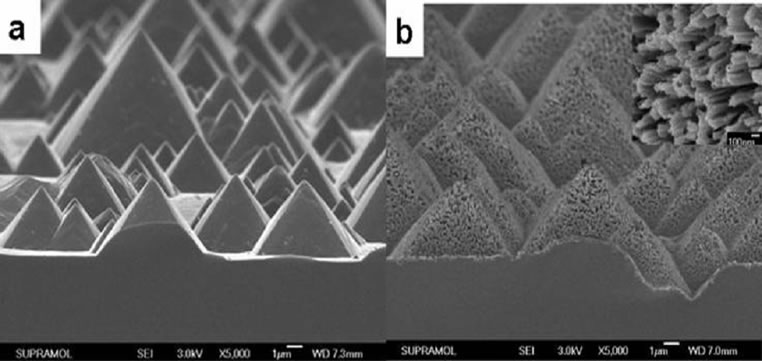
Figure 7. Cross-sectional SEM photographs of (a) silicon pyramids created with KOH etching and (b) hierarchical structures generated with Ag-assisted etching. Inset: magnified SEM image. Images reprinted from Ref. [58], with permission from American Chemical Society, Copyright 2009.
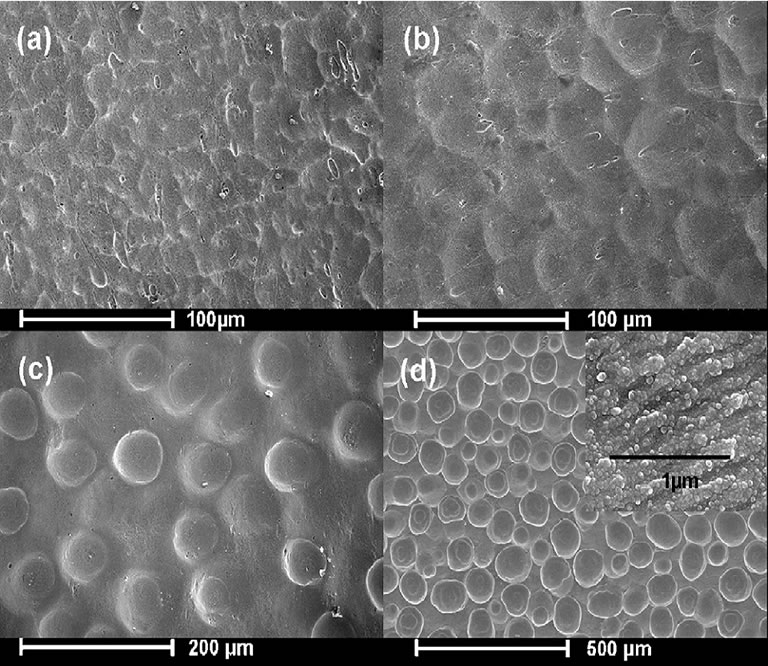
Figure 8. SEM images of the copper wafer surfaces etched under different conditions: (a) 5 M HNO3; (b) 5 M HNO3 under ultrasonication; (c) 5 M HNO3 with 1.2 mM CTAB; (d) 5 M HNO3 with 1.2 mM CTAB under ultrasonication. All the etching time is 20 min. Images reprinted from Ref. [60], with permission from Elsevier, Copyright 2010.
in a wide temperature range and in the corrosive liquids with a wide pH range. Such special superhydrophobic properties are able to greatly extend the application of copper in many important industrial fields.
Superhydrophobic surfaces (water contact angle: 158.4˚ ± 2˚, and sliding angle: 2.7˚ ± 1˚) on macroporous silicon films with moderate porosity (37.8%) and excellent mechanical properties (Young’s modulus, shear modulus and collapse strength are 64.2, 24.1 and 0.32 GPa, respectively) were prepared successfully by electrochemical etching under galvanostatic condition combined with subsequent octadecyltrichlorosilane (OTS) modification [61]. The SEM analysis (Figure 9) and fundamental calculation revealed that the 3D microstructures are important for macroporous silicon films to be mechanical stable and at the same time to possess surface superhydrophobicities. These results will be benefit to the practical applications of superhydrophobic surfaces, especially those with mechanical requirements, such as microfluidics. Wang et al. [62] fabricated a layer of flower-like superhydrophobic film on pure Mg surface by chemical etching in H2SO4, H2O2 and subsequent immersion in stearic acid (CH3(CH2)16COOH) ethanol solution. The superhydrophobic surface showed a static water contact angle of 154˚ with the sliding angle of about 3˚. The flower-like structure and the bonding of the CH3(CH2)16COOon Mg surface can be responsible for the superior water-repellent property. Electrochemical impedance spectroscopy revealed that the transfer resistance of super-hydrophobic
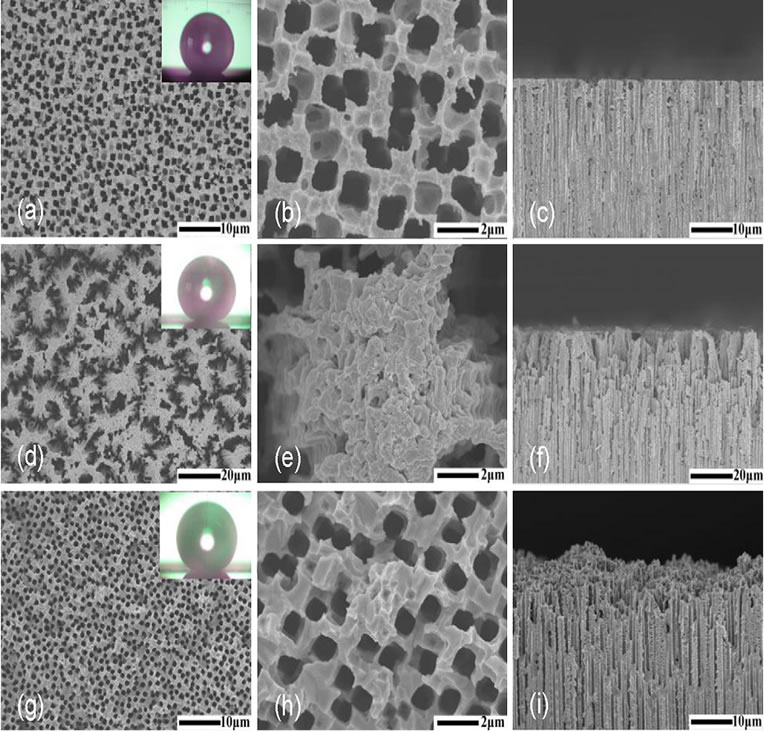
Figure 9. FE-SEM images of the hydrophobic PSi films prepared by electrochemical etching under galvanostatic condition: (a)-(c) 10 mA·cm−2 (PSi1); (d)-(f) 60 mA·cm−2 (PSi2); (g)-(i) 60 mA·cm−2, with subsequent ultrasonic cleaning (PSi2’). The water drops profiles on the corresponding surfaces are shown as the insets. Images reprinted from Ref. [61], with permission from Elsevier, Copyright 2011.
surface was increased about four times than bare Mg after one-hour immersion in 0.1 mol/L NaCl solution.
3.4. Hydrothermal Synthesis
Hydrothermal synthesis is a useful method for preparation of nanomaterials with novel and interesting morphologies. Gu et al. [63] successfully prepared superhydrophobic WO3 nanostructure films on alumina plates and tungsten foils by a facile hydrothermal method (Figure 10). By controlling the process of adsorption/desorption of ndodecanethiol associated with the Ag deposits on WO3 nanostructure surfaces, rapid changes of reversible wettability between superhydrophilicity and superhydrophobicity were realized. Noticeably, it takes only 25 min to fulfil the wettability change from superhydrophilicity to superhydrophobicity, and only 30 s to finish the reversed change. It is expected that the fast reversible wettability changes of WO3 surfaces between two extreme cases would find applications in smart devices. Xu et al. [64] employed a hydrothermal method to create superhydrophobic surfaces on cotton fabrics. Firstly, ZnO nanocrystals were prepared and applied to cotton fibers. Then, oriented ZnO nanorod arrays were fabricated on the fibers to form nanoscale roughness. Finally, the as-obtained fabrics were modified by dodecyltrimethoxysilane to obtain superhydrophobic surfaces. This method showed very good reproducibility and involved inexpensive laboratory equipment used for conventional textile processing.
Wu and Xia [65] fabricated a surface with microand nano-scale ZnO structure by alkaline hydrothermal method. The water contact angle on this double-roughness surface was low (down to ~0˚), but after spin coating Teflon, the contact angle was increased to ~168˚
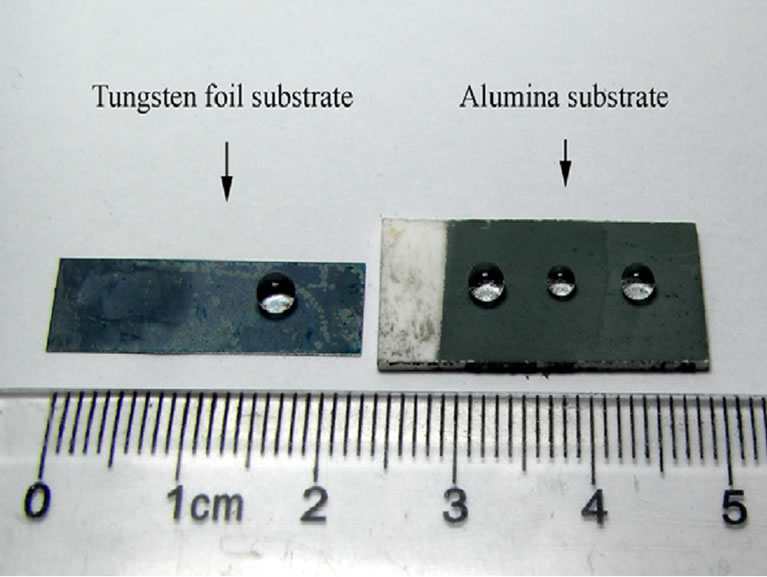
Figure 10. Photograph of water droplets on the superhydrophobic WO3 nanostructure films which were deposited on tungsten foil and alumina substrates, respectively. All surfaces were modified with light-induced plating Ag and immersion of n-dodecanethiol. Images reprinted from Ref. [63], with permission from Elsevier, Copyright 2010.
(Figure 11). The microstructural studies showed a “rose” like ZnO crystal surface structure, which was responsible for both superhydrophilicity and superhydrophobicity. The prepared surface also showed high chemical stability even after immersing the sample in water for 15 days. The method is simply controllable, cost-effective, and has a wide range of potential applications such as selfcleaning superhydrophobic coating on large areas of different substrates. Song et al. [66] presented a direct in-situ hydrothermal synthesis method for constructing three-dimensional (3D) flowerlike micro/nanoflakes on an iron plate surface. The micro-/nanostructure of the surface were readily controlled by adjusting the reaction temperature and the concentration of precursor. After chemical modification with vinyltirethoxysilane (VTS), the resultant surface covered by flower-like micro/nanoflakes revealed superhydrophobicity.
3.5. Phase Separation Method
A phase separation is simple and low cost method and mostly used to prepare a porous membrane of polymer. Khoo et al. [67] successfully prepared superhydrophobic 3D methyltrichlorosilane (MTS) nano-architectures on commercially available glass and SiO2 substrates with large varieties of morphologies through the control of several synthesis variables based on the phase separation method of MTS reagent. The morphology of the MTS nano-architecture strongly depends on the concentration of the reagent, reaction time, and humidity. Due to the effect of concentration, the MTS nanostructures evolved from discrete and short fibers to randomly integrated
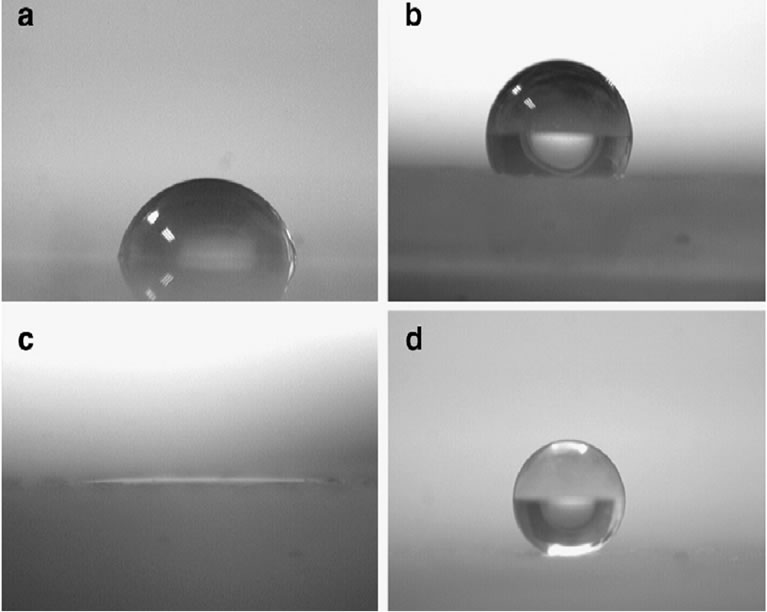
Figure 11. (a) Water droplet contact angle on plane ZnO surface; (b) The contact angle on Teflon modified plane ZnO surface; (c) Water droplet spreading on a superhydrophilic “rose” like ZnO surface and (d) a water bead standing on a Teflon-modified “rose” like ZnO surface. Images reprinted from Ref. [65], with permission from Elsevier, Copyright 2010.
fibrous quasinetworks and finally disintegrated into rougher discrete fibers again as the concentration increased. Song et al. [68] improved the synthesis method of 3,6-Odi-tertbutyldimethyl silyl chitosan (SC) and this polymer was used to prepare durable superhydrophobic films using a simple and low-cost phase separation method. The roughness of such films exhibited three levels of hierarchical organization and the film showed extreme hydrophobic property in the whole pH range.
A superhydrophobic methylsilicone resin film with luminescent property was prepared using phase separation method [69]. Figure 12 shows the emission spectra of the methylsilicone resin film with Eu(BA)3Phen and methylsilicone resin film.
The addition of europium complex (Eu(BA)3Phen) does not varied the wetting behaviour and the morphology of the as prepared film. Furthermore, luminescent property was introduced to the superhydrophobic film, which is useful to the application of superhydrophobic surface, such as the water repellence of light-emitting diode and the self-cleaning of road sign used in night. Wei et al. [70] synthesized styrene and 2,2,3,4,4,4-hexafluorobutyl methacrylate copolymers by bulk polymerization, and the superhydrophobic copolymer films were prepared subsequently using phase separation technique. The copolymer was dissolved in tetrahydrofuran, and then added
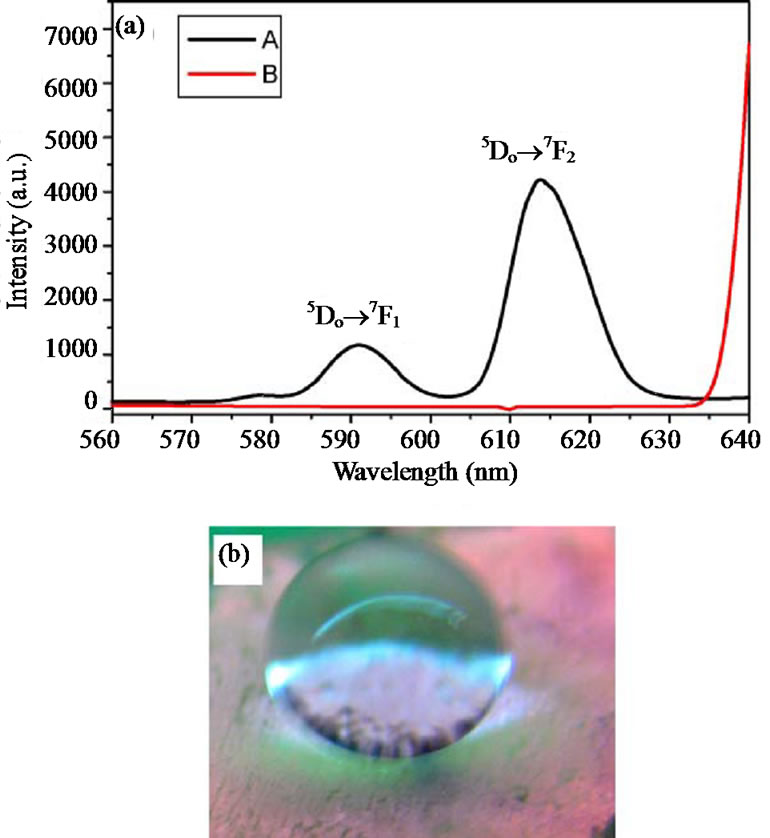
Figure 12. (a) The emission spectra of (A) methylsilicone resin film with Eu(BA)3Phen and (B) methylsilicone resin film; (b) Optical image of water droplet on the methylsilicone resin film with Eu(BA)3Phen under UV light. Images reprinted from Ref. [69], with permission from Elsevier, Copyright 2009.
ethanol into the solution thereafter, to induce phase separation. The microstructures of the polymer films (Figure 13) were controlled by the degree of phase separation, which was enhanced properly by the concentration of ethanol.
3.6. Self-Assembly and Layer-by-Layer Methods
Self-assembly and layer-by-layer are easy and economical methods to prepare superhydrophobic surface structures. Xu and Wang [71] prepared optically transparent and superhydrophobic coatings by self-assembly of dualsized silica particles from a mixed dispersion. The desirable micro-/nano hierarchical structure for superhydrophobicity was constructed simply by adjusting the size and ratio of the dual-sized particles without organic/inorganic templates. Moreover, the whole assembly process was completed under mild conditions in only half an hour and has advantages for large-scale coating. Song et al. [72] fabricated the superhydrophobic surfaces by applying an octadecyltrichlorosilane (OTS) self assembled monolayer (SAM) on silicon micro/nanotextured surfaces produced by the aluminium induced crystallization (AIC) of amorphous Si (a-Si) technique. It was shown that this novel technique can significantly improve the hydrophobicity of a silicon surface, resulting in superhydrophobic surfaces with a WCA of 155˚ and a sliding
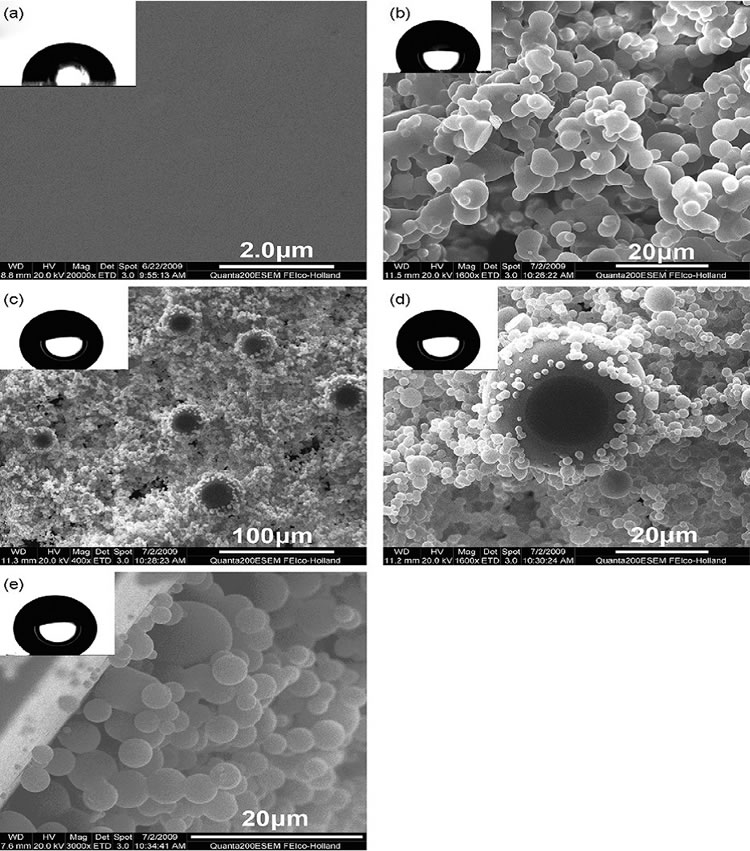
Figure 13. ESEM images of copolymer films obtained with different ethanol content in copolymer solution: (a) 0%; (b) 30%; (c) 50%; (d) is the higher magnification ESEM image of (c); (e) is the section image of (c). Insets are the water contact angles on the copolymer films. Images reprinted from Ref. [70], with permission from Elsevier, Copyright 2010.
angle of less than 1˚. Since the chemistry of OTS SAMs is well developed and AIC of a-Si has been extensively studied in the semiconductor and MEMS industries, using a combination of such well developed technologies to produce superhydrophobic surfaces has great potential in the MEMS industry. Yang et al. [73] demonstrated a convenient and effective method to prepare superhydrophobic films by means of employing mulberry-like CaCO3/ SiO2 composite particles, which originated from violent stirring and surface modification, and self-assembly of polydimethylsiloxane. Compared with other complex processes, this procedure is simple and potentially usable to fabricate large-area superhydrophobic surfaces for practical self-cleaning applications.
Layer-by-layer (LBL) deposition is based on the electrostatic charge interactions between the different layers such as polyanion and polycation. The LBL technique is easy to perform and allows controlling the thickness of the resulting layer with molecular precision. Zao et al. [74] rendered highly hydrophilic cotton fabrics into superhydrophobic via electrostatic layer-by-layer assembly of polyelectrolyte/silica nanoparticle multilayers on cotton fibers, followed with a fluoroalkylsilane treatment (Figure 14).
The surface morphology of the silica nanoparticlecoated fibers, which results in the variety of the hydrophobicity, was tailored by controlling the number of multilayers. Although with the static water contact angle larger than 150˚, in the case of 1 or 3 multilayers, the fabrics showed sticky property with a high contact angle hysteresis (>45˚). For the cotton fabrics assembled with 5
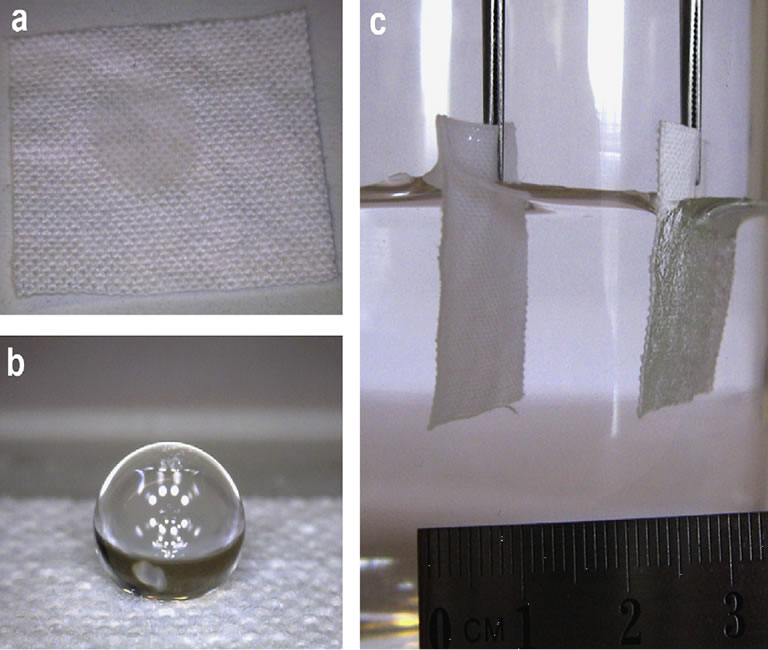
Figure 14. Photographs of water drops on (a) untreated cotton fabric and (b) superhydrophobic cotton fabric assembled with (PAH/SiO2)5 multilayers. (c) Untreated (left) and superhydrophobic (right) cotton fabrics being immersed in water. Images reprinted from Ref. [74], with permission from Elsevier, Copyright 2010.
multilayers or more, slippery superhydrophobicity with a contact angle hysteresis lower than 10˚ was achieved. The buoyancy of the superhydrophobic fabric was examined by using a miniature boat made with the fabric (Figure 15). The superhydrophobic fabric boat exhibited a remarkable loading capacity; for a boat with a volume of 8.0 cm3, the maximum loading was 11.6 or 12.2 g when the boat weight is included. Moreover, the superhydrophobic cotton fabric showed a reasonable durability to withstand at least 30 machine washing cycles.
Jindasuwan et al. [75] dip-coated a water-repellent film onto the glass substrate by mimicking a unique surface feature of the lotus leaf by a layer-by-layer deposition of polyelectrolyte, followed by SiO2 particle to modify surface roughness, and finally a semifluorinated silane to lower the surface energy. The SiO2 particles were incurporated at different content to modify the film’s surface roughness. By increasing the SiO2 content, the films hydrophobicity increased as a result of increasing surface roughness. Amigoni et al. [76] constructed hybrid organic/inorganic surfaces by alternating different layers of amino-functionalized silica nanoparticles and epoxy-functionalized silica nanoparticles. Then, hydrophobization of the last layer of amino-functionalized silica particles was carried out by grafting a newly designed, highly fluorinated aldehyde, creating a monomolecular layer via the

Figure 15. Photographs of a loaded superhydrophobic fabric boat floating on water surface: (a) Top view; (b) Side view. Images reprinted from Ref. [74], with permission from Elsevier, Copyright 2010.
formation of an imine. The hydrophobicity increased with the number of layers, and stable, highly superhydrophobic surfaces were obtained.
3.7. Plasma Treatment
A plasma treatment of surfaces always involves plasma etching. Plasma treatment of surfaces can cause a significant change in the surface micro-/nanostructure because of the anisotropic etching of the surface layers. Ji et al. [77] demonstrated a simple method for fabricating a superhydrophobic coating on glass by using in-line atmospheric RF glow discharge plasma with a non-polar aromatic toluene and HMDSO mixture. The glass treated with the HMDSO/toluene plasma showed superhydrophobicity with a water contact angle of about 150˚, which is attributed to its high content of non-polar hydrophobic phenyl groups and its rough surface (Figure 16). This plasma system does not require any vacuum instruments, and is operated in an in-line mode rather than a batch mode. Therefore, this technique can easily be scaled up for treating larger substrates and for continuous processing.
Yang et al. [78] deposited superhydrophobic films in a
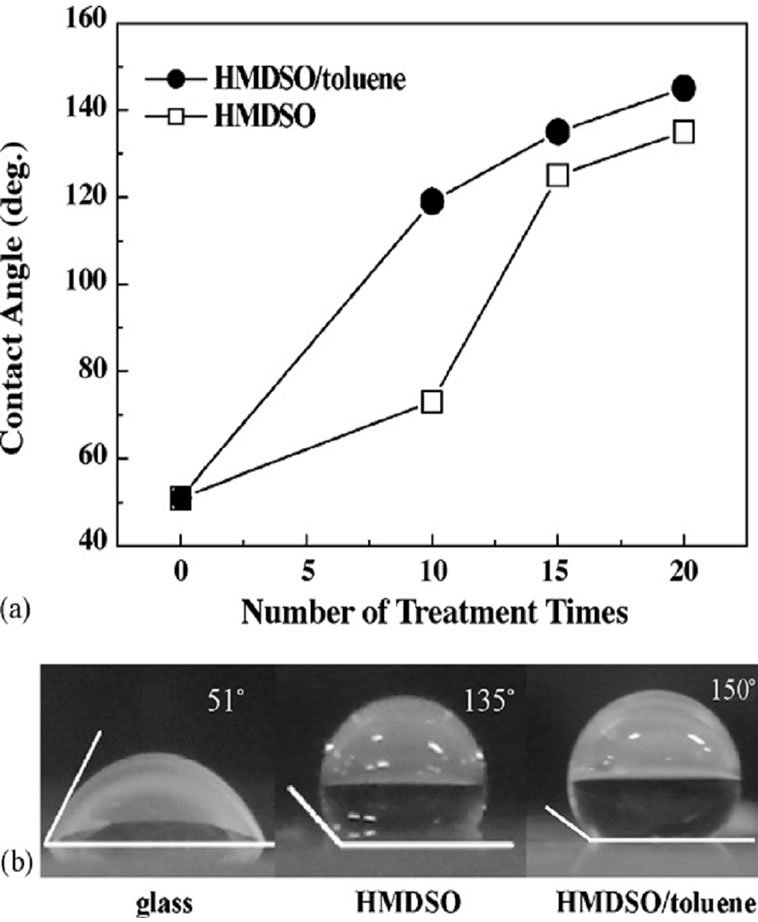
Figure 16. (a) Contact angle as a function of the number of plasma treatments; (b) Photographs of a water droplet on: (from left to right) untreated glass, HMDSO plasma-treated glass (20 repeated treatments), and toluene/HMDSO plasma treated glass (20 repeated treatments). Images reprinted from Ref. [77], with permission from Elsevier, Copyright 2009.
one-step simple process by pulsed RF C6F6 plasma, and the influence of the duty-cycle (DC) on the surface structure and chemical characteristics of the deposited fluorocarbon films was examined. When the DC was decreased from 1 to 0.1, the smooth surface transformed into a roughly structural surface with low surface energy resulted in a desirable superhydrophobic surface property. Banerjee et al. [79] reported the effect of deposition pressure on the surface topology and thereby on the hydrophobicity of amorphous carbon films synthesized by direct currentplasma enhanced chemical vapor deposition (PECVD). The effect of pH of water on the hydrophobicity was also studied and it was found that contact angle was nearly independent of pH of water. Mundo et al. [80] reported the roughening of polystyrene by means of RF plasma treatments fed with CF4 to prepare superhydrophobic surface. Surfaces etched for 10 min CF4 plasma and coated with a 45 s long C4F8 PECVD process, beside the slippery superhydrophobicity, showed a reduction of the visible light reflectance allowing for a transmittance gain, suitable for optical application.
3.8. Solution Immersion Method
A solution immersion method is time-saving procedure and needed cheap reagents. The approach is fairly facile to operate and no special technique or equipment is required. Kong et al. [81] reported a novel solution-immersion method for the fabrication of superhydrophobic surfaces on copper substrates. A slice-like Cu2(OH)3NO3 crystal was prepared on the surface of the copper foil (Figure 17) by sequential immersing in an aqueous solution of sodium hydroxide and cupric nitrate and the superhydrophobic structure was obtained by modifying the slice-like Cu2(OH)3NO3 crystal with 1H,1H,2H,2H-perfluorodecyltriethoxysilane (FAS-17). Liu et al. [82] fabricated a new hierarchical CuO architecture consisting of densely packed nanoplates and nanoribbons directly on Cu foils via a room temperature solution-immersion process. The as-prepared film has shown excellent superhydrophobicity after simple modification with commercial wax, which is a cheap low-surface-energy material. Liu et al. [83] fabricated stable superhydrophobic films on zinc substrates by a simple immersion technique into a methanol solution of hydrolyzed 1H,1H,2H,2H-perfluorooctyltrichlorosilane [CF3(CF2)5(CH2)2SiCl3, PFTS] for 5 days at room temperature followed by a short annealing at 130˚C in air for 1 h. The superhydrophobic film provides an effective corrosion resistant coating for the zinc interface when immersed in an aqueous solution of sodium chloride (3% NaCl) for nearly one month.
Li et al. [84] used a commercially available, waterproof reagent potassium methyl siliconate (PMS) for fabricating superhydrophobic surfaces on cellulose based materials through a solution-immersion method (Figure 18).
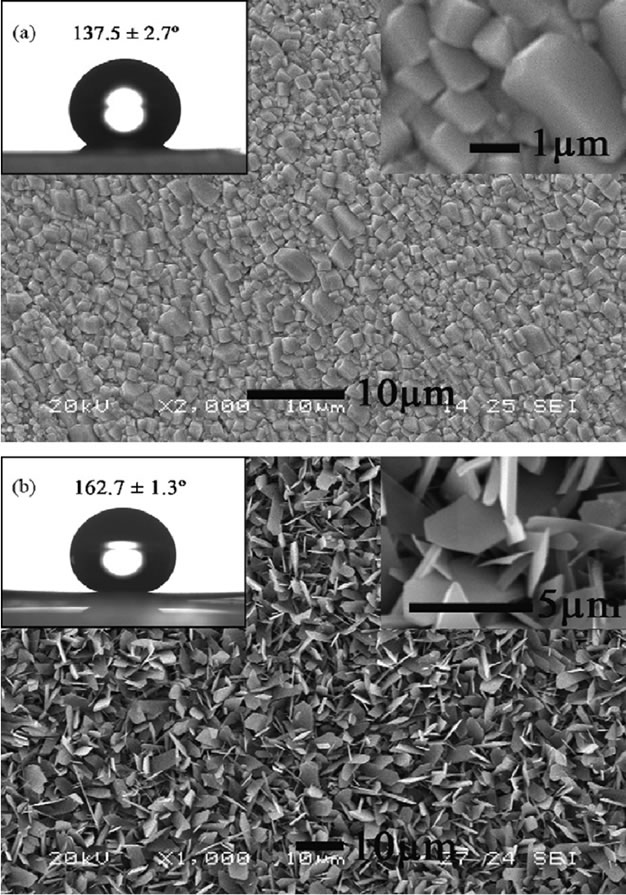
Figure 17. SEM images of (a) Cu2Omicro-crystal and (b) slice-like Cu2(OH)3NO3 crystal. Images reprinted from Ref. [81], with permission from Elsevier, Copyright 2008.

Figure 18. FE-SEM images of (a) the native cotton fiber, (b) the modified cotton fiber, and (c) the modified cotton fabric at low-magnification. (d) A three-dimensional AFM image of the modified fiber surface, (e) an image of water droplets on the surface of the modified colorized cotton fabric, and (f) an image of water droplets on the surface of the modified filter paper. Images reprinted from Ref. [84], with permission from American Chemical Society, Copyright 2008.
The silanol, which was formed by a reaction of a PMS aqueous solution with CO2, was assembled on the cellulose molecule surface via hydrogen bond interactions, and the superhydrophobic coatings were formed by a subsequent polycondensation reaction. This reaction process resulted in the covalent attachment of a polymethylsilsesquioxane layer to the surfaces of the cellulose fibers. Uniform nanoscale roughness protuberances with inherent microscale roughness characteristics were obtained, thus bringing about a superhydrophobic character coupled with a satisfactory durability.
3.9. Chemical Vapour Deposition
Chemical vapor deposition is a technique whereby gaseous reactants can be deposited onto a substrate to form a nonvolatile solid film. CVD is also an efficient and often preferred process to build micro-/nanoparticles, nanorods into ordered macroscopic structures. Hozumi et al. [85] demonstrated tuning of the dynamic wettability of oxidized aluminum and titanium surfaces using a vapour phase reaction of 1,3,5,7-tetramethylcyclotetrasiloxane (C4H16O4Si4). By only regulating CVD temperatures, hydrophilic oxidized aluminum and titanium surfaces became low-hysteresis hydrophobic/superhydrophobic surfaces. Liquid drops on such surfaces moved spontaneously without “pinning” when the surfaces were slightly tilted. Control of liquid mobility on various metal surfaces is important and surfaces with negligible contact angle hysteresis would be ideal for numerous practical applications. Hsieh et al. [86] fabricated a superhydrophobic carbon fabric with micro/nanoscaled two-tier roughness by decorating carbon nanotubes (CNTs) onto microsized carbon fibers, using a catalytic chemical vapour deposition (CCVD) and subsequent fluorination surface treatment (Figure 19). The superhydrophobic surfaces were based on the regularly ordered carbon fibers (8 - 10 µm in diameter) that are decorated by CNTs with an average size of 20 - 40 nm. The contact angle of water significantly increased from 148.2˚ ± 2.1˚ to 169.7˚ ± 2.2˚ through the introduction of CNTs. This work sheds some light on the superhydrophobicity of the carbon surface, showing a resemblance to lotus leaves in nature, and on how the decoration of CNTs affects the wetting property.
Zimmermann et al. [87] prepared superhydrophobic textile fabrics via a one-step gas phase coating procedure by growing a layer of polymethylsilsesquioxane nanofilaments onto individual textile fibers (Figure 20). Eleven textile fabrics made from natural and synthetic fibers were successfully coated and their superhydrophobic properties were evaluated. A thorough investigation of the commercially relevant poly(ethylene terephthalate) fabric revealed an unparalleled long-term water resistance and stability of the superhydrophobic effect. Because of the special surface geometry generated by the nanoscopic,
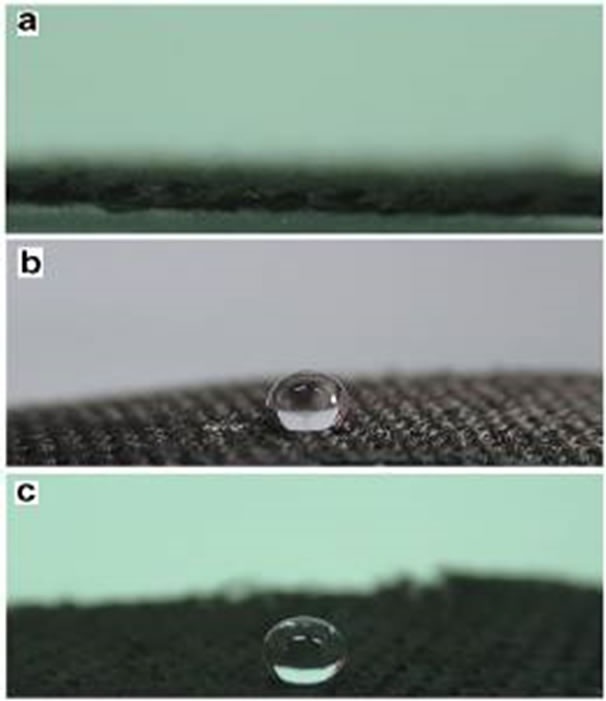
Figure 19. Tilt-view photographs for water droplet sat on: (a) The untreated carbon fabric, (b) The fluorinated carbon fabric, and (c) the fluorinated carbon fabric with two-tier roughness. The untreated sample exhibits a hydrophilic ability so that the drop rapidly becomes water film. All photos of water droplets were taken by a digital camera. Images reprinted from Ref. [86], with permission from American Chemical Society, Copyright 2008.
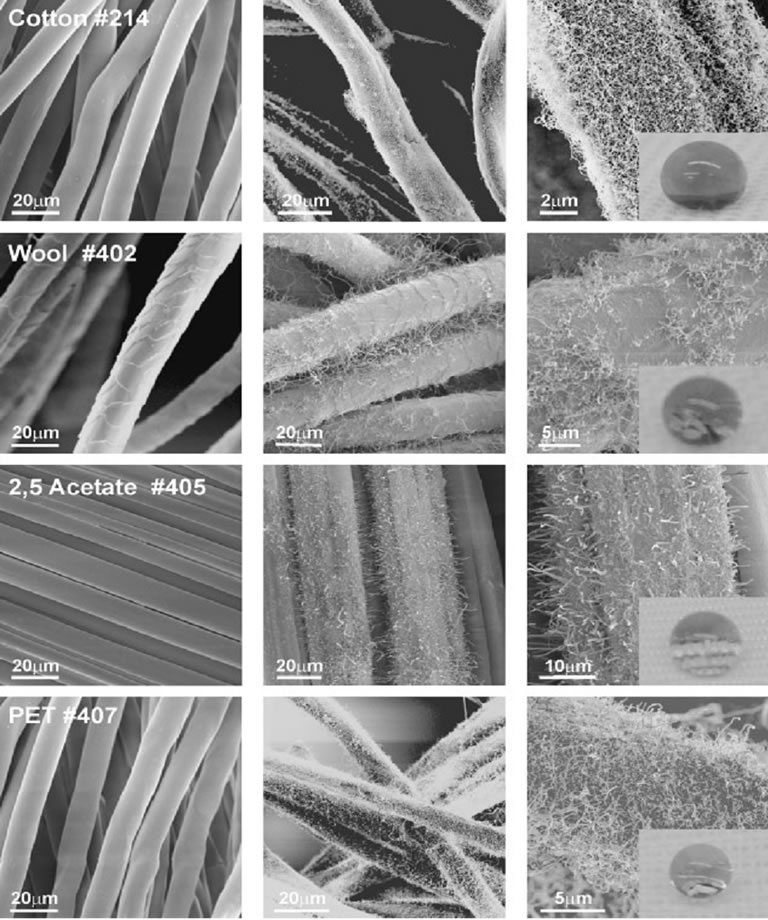
Figure 20. SEM images of textile fabrics: left: uncoated; middle and right: coated with silicone nanofilaments. Insets show a drop of water deposited on the respective coated fabrics. Images reprinted from Ref. [87], with permission from WILEY-VCH Verlag GmbH & Co. KGaA, Weinheim, Copyright 2008.
fibrous coating on the microscopic, fibrous textiles, the coated fabric remained completely dry even after two months of immersion in water and remained superhydrophobic even after continuous rubbing with a skin-simulating material under a significant load. Furthermore, important textile parameters such as tensile strength, color and haptics were unaffected by the silicone nanofilament coating.
Lee et al. [88] developed vertically-aligned multiwalled carbon nanotubes (CNTs) on stainless steel (SS) mesh by thermal chemical vapor deposition with a diffusion barrier of Al2O3 film. These three-dimensional porous structures (SS-CNT meshes) were found to be superhydrophobic as well as superoleophilic. Water contact angles of 145˚ - 150˚ were determined for these SS-CNT meshes in air and oil (gasoline, isooctane). Oil, on the other hand, completely wet the SS-CNT meshes. This combined superhydrophobic and superoleophilic property repelled water while allowed the permeation of oil. Filtration tests demonstrated efficiencies better than 80% of these SS-CNT meshes as the filtration membranes of the water in-oil emulsions. Recently, first time in the literature, Yao et al. [89] synthesized a novel ZnS hierarchical structure composed of nanorod arrays with branched nanosheets and nanowires grown on their upside walls, over Au-coated silicon substrate via chemical vapour deposition technique. The prepared surface showed the capability of self-cleaning behaviour similar to the lotus effect. This work possibly actuates the coming researches on water-repellent properties of ZnS nanostructures and will induce its application in self-cleaning surface, antifogging or other fields.
3.10. Sol-Gel Method
The surface roughness obtained with the sol-gel method can be easily tuned by changing the protocol of the method and the composition of the reaction mixture [90-95]. Usually a sol is prepared by hydrolysis and polycondensation of the corresponding oxide in the presence of solvent. During the network formation process, a large amount of solvent are also impregnated in the network and thus a gel is formed. The sol can be applied on the substrates either directly or combined with fillers such as silica nanoparticles [96-100]. Basu et al. [101] fabricated binary micro-nano-structured sol-gel coatings by spraying precursor mixtures containing hydrophobically modified silica (HMS) nanoparticles dispersed in sol-gel matrices prepared with acid-catalyzed tetraethoxysilane (TEOS), and methyltriethoxysilane (MTEOS). The hydrophobicity of the coatings was increased with increase in the concentration of HMS nanoparticles. Superhydrophobic coatings with water contact angle of 166˚ and roll off angle ~ 2˚ were obtained by optimizing the sol-gel processing parameters and the concentration of silica nanoparticles in the coating. Xiu et al. [102] incorporated isobutyltrimethoxysilane into silica layers, which produced hydrophobic isobutyl surface groups and generated surface hydrophobicity. Gan et al. [103] fabricated highly hydrophobic surfaces on cotton and polyester fabrics using a silica sol-gel coating and treatment with hydrolyzed hexadecyltrimethoxysilane. The processed textile fabrics showed excellent water repellency with water contact angles as high as 155˚ on cotton and 143˚ on polyester.
Shang et al. [104] prepared the durable superhydrophobic cellulose fabric from water glass and n-octadecyltriethoxysilane (ODTES) with 3-glycidyloxypropyltrimethoxysilane (GPTMS) as crosslinker by sol-gel method. The addition of GPTMS could result in a better fixation of silica coating from water glass on cellulose fabric and the chemical bonding between cotton fabric and silica functional layer through GPTMS provided a significant enhancement in washing durability of hydrophobicity. In the same way, Li et al. [105] used sodium silicate, a cheap and commonly used industrial raw material, as the precursor to prepare a silica sol by acid-catalyzed hydrolysis and condensation. After dip-coating the silica sol onto cotton surfaces, the surfaces were modified with hexadecyltrimethoxysilane (HDTMS) to obtain a thin layer through self-assembly. The treated cotton fabrics exhibited superhydrophobicity. Lakshmi and Basu [106] fabricated a superhydrophobic sol-gel composite film by incorporating hydrophobically modified colloidal zinc hydroxide (CZH) in an acid-catalyzed sol of tetraethoxysilane (TEOS) and methyltriethoxysilane (MTEOS) and spray-coated on glass slides. The concentration of CZH in the composite film was optimized to obtain superhydrophobic surfaces. It is also feasible for application on large areas and non-planar substrates. Xu et al. [107] successfully fabricated an organic-inorganic composite coating with superhydrophobicity, good transparency, and thermal stability by a simple sol-gel dip-coating method based on partially reversible aggregation of silica colloid particles (Figure 21). The silica colloid particles aggregated by poly-Aminopropyltriethoxysilane (poly-APS) were redispersed partially by ultrasonic vibration, forming a lot of small aggregates. These aggregates were consequently assembled onto the glass substrate by dip coating. It was observed that the surface structure, superhydrophobicity, and transparency can be controlled by adjusting the APS concentration.
Wang et al. [108] have produced stable superhydrophobic surfaces with water contact angles over 170˚ and sliding angles below 7˚ by simply coating a particulate silica sol solution of cohydrolyzed tetraethoxysilane/ fluorinated alkyl silane with NH3·H2O on various substrates, including textile fabrics (e.g. polyester, wool and cotton) and electrospun nanofiber mats. Taurino et al. [109] prepared superhydrophobic films by applying multilayer
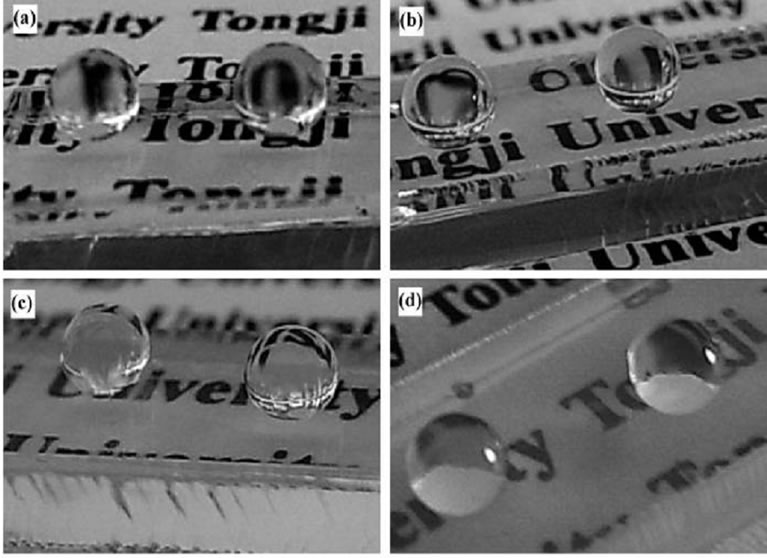
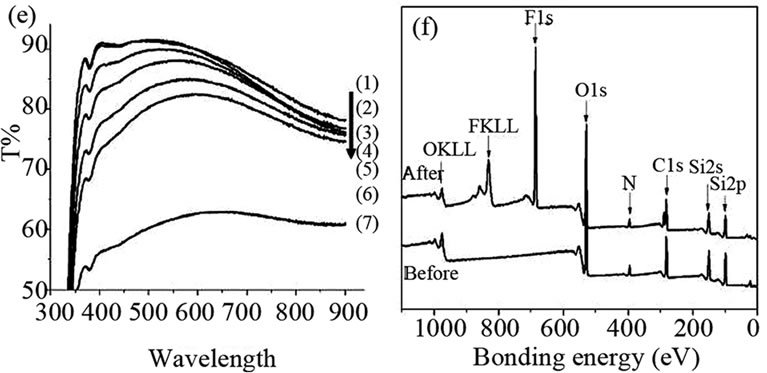
Figure 21. Optical images of glass substrates with superhydrophobic coatings from sols containing (a) 0.36% APS, (b) 0.48% APS, (c) 0.6% APS, and (d) 0.72% APS; transmittance results of different glass substrates (e) [(1) not coated, (2)-(7) dip-coated from sols containing 0.12, 0.24, 0.36, 0.48, 0.6, and 0.72% APS], and XPS spectra of the coatings before and after FAS modification (f). Images reprinted from Ref. [107], with permission from American Chemical Society, Copyright 2010.
sol-gel coatings based on TiO2-ZrO2-SiO2 and a silaneterminated perfluoropolyether to a glass substrate by combining air-brushing and spin-coating procedures. The coatings combined with suitable chemical compositions and surface roughness showed both high contact angle and low hysteresis values. Xiu et al. [110] used a eutectic liquid (choline chloride and urea) that served as a templating agent in sol-gel processing to prepare thin silica films on glass microscope slides. Subsequent extraction of the eutectic liquid yielded a film with a rough surface. After treating the film surface with a fluoroalkyl silane, the surface became superhydrophobic with a contact angle 170˚ and a contact angle hysteresis 10˚. The optical transmittance of the film coated on the glass slide was comparable to that of the microscope glass slide.
3.11. Casting Method
Compared with other sophisticated methods, casting method is simple and does not need special equipment or rigorous conditions. Hou et al. [111] successfully prepared a polypropylene/methyl-silicone based superhydrophobic composite film using a simple casting method. The microstructure and sliding angle of the as-prepared surface was influenced due to change in ratio between methyl-silicone and polypropylene. The wettability of the as-prepared surface varied with the drying temperature. The liquid separation experiments showed that the PP monolithic material can be used to separate the mixture of water and some organic solvents. Steele et al. [112] presented a conformal coating process to transform surfaces with inherent micro-morphology into superhydrophobic surfaces with hierarchical surface structure using wet chemical spray casting. Nanocomposite coatings composed of zinc oxide nanoparticles and organosilane quaternary nitrogen compound are dispersed in solution for application. The coating is applied to a micro-patterned polydimethylsiloxane substrate with a regular array of cylindrical microposts as well as a surface with random micro-structure for the purpose of demonstrating improved non-wettability and a superhydrophobic state for water droplets.
Recently, Guo et al. [113] fabricated a superhydrophobic SiO2/nylon 6,6 nanocomposite coating by a facile casting process. Compared with the intrinsically hydrophilic pure nylon 6,6, the as-prepared coating displayed a superhydrophobic property in the pH range from 1 to 14. It was also found that the resulting water contact angles of the as-prepared surface were always larger than 159˚, but the sliding angles was decreased from about 33.4˚ to 1˚ as the content of SiO2 nanoparticles increased. This process could be applied to other hydrophilic polymers to produce superhydrophobic surfaces, thereby extending the use of such materials for super wetting applications. Yang et al. [114] reported a polymer functionalized CNT film with superhydrophobic and transparent properties fabricated by one-step spray casting CNT-polystyrene suspensions. Such a film showed not only stable superhydrophobic property with water contact angle of about 160˚ and a slide angle less than 3˚ (Figure 22) but also high light transmittance in the visible light region (Figure 23).
4. Conclusions and Outlook
In this review, the recent advancements in bio-inspired superhydrophobic surfaces and their functions have been described. To mimic the naturally found superhydrophobic surfaces, many approaches have been developed for the creation of artificial superhydrophobic surfaces by adopting the central idea of surface micro-/nanostructure and surface chemical composition. The superhydrophobic surfaces show some amazing properties such as antisticking, anti-contamination, and self-cleaning. These surfaces with special wettabilities have potential promising application in industry. Since last two decades, the
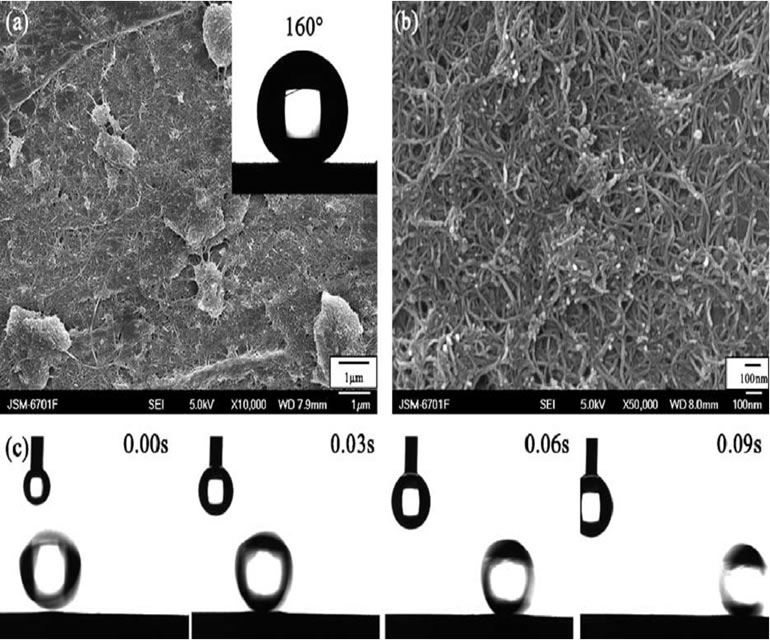
Figure 22. FESEM images of the MWCNT-PS film: (a) Low magnification (inset image indicates the CA of a 5 mL water droplet on the film) and (b) high magnification. (c) The rolling process of the water droplet on the superhydrophobic MWCNT–PS film. Images reprinted from Ref. [113], with permission from Elsevier, Copyright 2009.
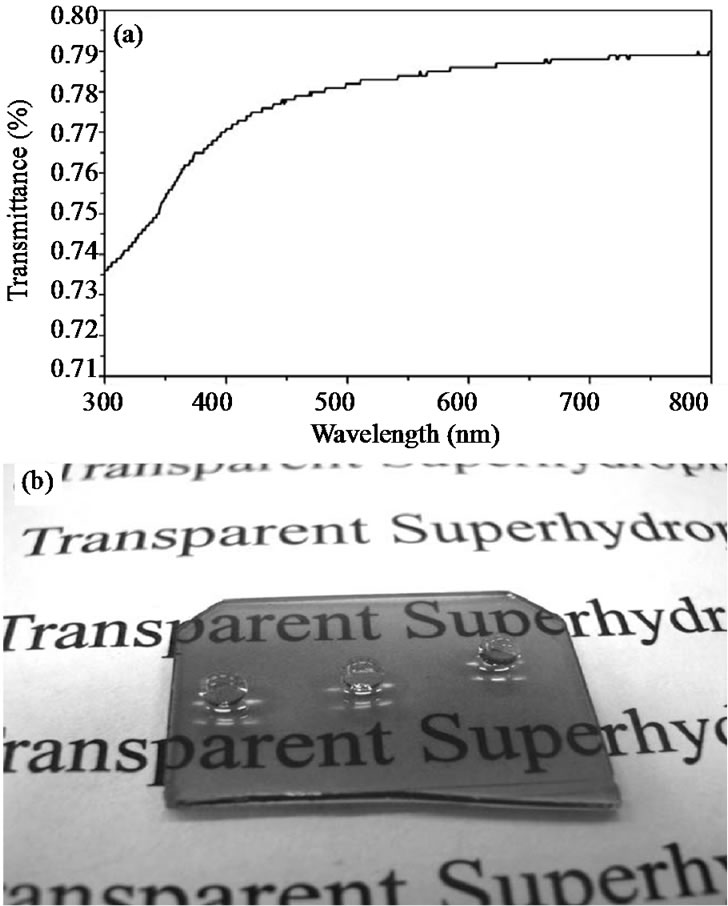
Figure 23. (a) The transmittance spectra of the MWCNT– PS film; (b) A photograph of water droplets on the transparent and superhydrophobic film. Images reprinted from Ref. [113], with permission from Elsevier, Copyright 2009.
efforts have been devoted for the development of synthesis techniques to construct superhydrophobic surfaces, but most of them are restricted to laboratory research and there is still much work required for superhydrophobic surfaces to be incorporated into commercial products. Until now, scientists are partly successful in mimicking natural superhydrophobic surfaces, but failed to maintain its life time (permanent) superhydrophobicity. To develop superhydrophobic surfaces in an industrial scale, a plenty of research work should be done in near future by combining new theoretical models with recently developed synthesis techniques to find out the relationship between composition, structure, and other properties to get durable superhydrophobic surfaces. Besides durability, issues such as large scale production and the availability and price of raw materials should also be taken into account. This will be beneficial for the practical application of superhydrophobic surfaces in real life.
Hierarchical micro-/nanostructures are typical for the surfaces with superhydrophobic, self-cleaning, low adhesion and drag reduction in nature. The development of superhydrophobic and self-cleaning surfaces is important for basic research as well as various applications, such as anti-biofouling paints for boats, antisticking of snow for antennas and windows, self-cleaning windshields for automobiles, microfluidics, lab-on-a chip devices, metal refining, stain resistant textiles, anti-soiling architectural coatings, dust-free coatings on building glasses and so on. It will be great challenge for the material scientists to fabricate permanent or semi-permanent superhydrophobic surfaces for its use in commercial products. At last, for the preparation of superhydrophobic surfaces, we suggest to use alternative eco-friendly chemicals for fluorine containing chemicals and organic chemicals which are dangerous for human health and environment.
NOTES